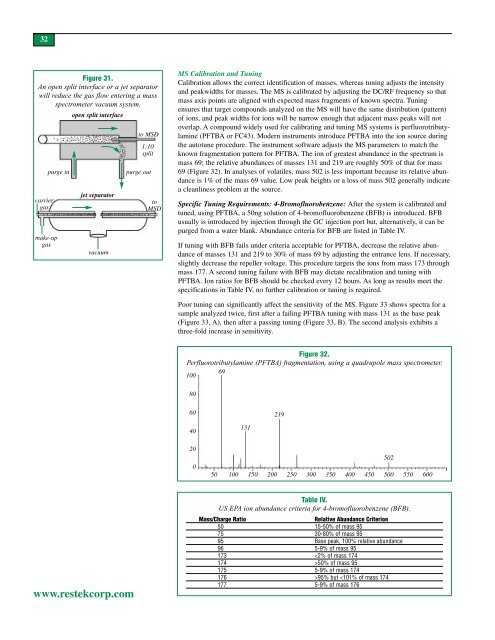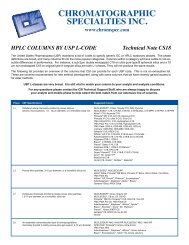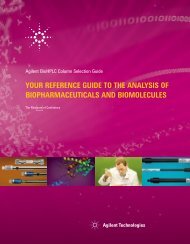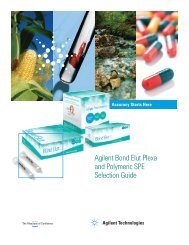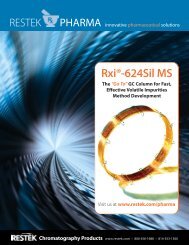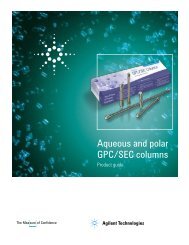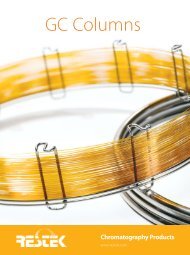Optimizing the Analysis of Volatile Organic Compounds
Optimizing the Analysis of Volatile Organic Compounds
Optimizing the Analysis of Volatile Organic Compounds
Create successful ePaper yourself
Turn your PDF publications into a flip-book with our unique Google optimized e-Paper software.
32<br />
Figure 31.<br />
An open split interface or a jet separator<br />
will reduce <strong>the</strong> gas flow entering a mass<br />
spectrometer vacuum system.<br />
carrier<br />
gas<br />
make-up<br />
gas<br />
purge in<br />
open split interface<br />
jet separator<br />
vacuum<br />
www.restekcorp.com<br />
to MSD<br />
1:10<br />
split<br />
purge out<br />
to<br />
MSD<br />
MS Calibration and Tuning<br />
Calibration allows <strong>the</strong> correct identification <strong>of</strong> masses, whereas tuning adjusts <strong>the</strong> intensity<br />
and peakwidths for masses. The MS is calibrated by adjusting <strong>the</strong> DC/RF frequency so that<br />
mass axis points are aligned with expected mass fragments <strong>of</strong> known spectra. Tuning<br />
ensures that target compounds analyzed on <strong>the</strong> MS will have <strong>the</strong> same distribution (pattern)<br />
<strong>of</strong> ions, and peak widths for ions will be narrow enough that adjacent mass peaks will not<br />
overlap. A compound widely used for calibrating and tuning MS systems is perfluorotributylamine<br />
(PFTBA or FC43). Modern instruments introduce PFTBA into <strong>the</strong> ion source during<br />
<strong>the</strong> autotune procedure. The instrument s<strong>of</strong>tware adjusts <strong>the</strong> MS parameters to match <strong>the</strong><br />
known fragmentation pattern for PFTBA. The ion <strong>of</strong> greatest abundance in <strong>the</strong> spectrum is<br />
mass 69; <strong>the</strong> relative abundances <strong>of</strong> masses 131 and 219 are roughly 50% <strong>of</strong> that for mass<br />
69 (Figure 32). In analyses <strong>of</strong> volatiles, mass 502 is less important because its relative abundance<br />
is 1% <strong>of</strong> <strong>the</strong> mass 69 value. Low peak heights or a loss <strong>of</strong> mass 502 generally indicate<br />
a cleanliness problem at <strong>the</strong> source.<br />
Specific Tuning Requirements: 4-Brom<strong>of</strong>luorobenzene: After <strong>the</strong> system is calibrated and<br />
tuned, using PFTBA, a 50ng solution <strong>of</strong> 4-brom<strong>of</strong>luorobenzene (BFB) is introduced. BFB<br />
usually is introduced by injection through <strong>the</strong> GC injection port but, alternatively, it can be<br />
purged from a water blank. Abundance criteria for BFB are listed in Table IV.<br />
If tuning with BFB fails under criteria acceptable for PFTBA, decrease <strong>the</strong> relative abundance<br />
<strong>of</strong> masses 131 and 219 to 30% <strong>of</strong> mass 69 by adjusting <strong>the</strong> entrance lens. If necessary,<br />
slightly decrease <strong>the</strong> repeller voltage. This procedure targets <strong>the</strong> ions from mass 173 through<br />
mass 177. A second tuning failure with BFB may dictate recalibration and tuning with<br />
PFTBA. Ion ratios for BFB should be checked every 12 hours. As long as results meet <strong>the</strong><br />
specifications in Table IV, no fur<strong>the</strong>r calibration or tuning is required.<br />
Poor tuning can significantly affect <strong>the</strong> sensitivity <strong>of</strong> <strong>the</strong> MS. Figure 33 shows spectra for a<br />
sample analyzed twice, first after a failing PFTBA tuning with mass 131 as <strong>the</strong> base peak<br />
(Figure 33, A), <strong>the</strong>n after a passing tuning (Figure 33, B). The second analysis exhibits a<br />
three-fold increase in sensitivity.<br />
Figure 32.<br />
Perfluorotributylamine (PFTBA) fragmentation, using a quadrupole mass spectrometer.<br />
69<br />
100<br />
80<br />
60<br />
40<br />
20<br />
0<br />
131<br />
219<br />
50 100 150 200 250 300 350 400 450 500 550 600<br />
Table IV.<br />
US EPA ion abundance criteria for 4-brom<strong>of</strong>luorobenzene (BFB).<br />
Mass/Charge Ratio Relative Abundance Criterion<br />
50 15-50% <strong>of</strong> mass 95<br />
75 30-80% <strong>of</strong> mass 95<br />
95 Base peak, 100% relative abundance<br />
96 5-9% <strong>of</strong> mass 95<br />
173 50% <strong>of</strong> mass 95<br />
175 5-9% <strong>of</strong> mass 174<br />
176 >95% but


